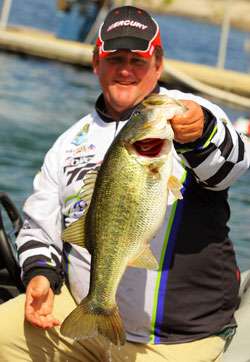
Editor's Note: In this two-part series we examine the role size plays in selecting the right swimbait for your fishing. Elite Series pro, Byron Velvick, will offer his perspective on why he likes big baits. His fellow competitor on the trail, Kenyon Hill, will tell us why he likes to go small. Of course, you have to make the final decision.
Part 2: Think Small
Small swimbaits will catch more bass. It's that simple. I'm not saying there isn't an application for big baits or that they don't have their place in your tacklebox. They do. I am saying, however, that over the course of a fishing year you'll catch more bass if you go small with your swimbaits.
Look around your local lake or river. Most of the forage is relatively small. In most cases it'll measure 3 or 4 inches, sometimes smaller than that. A bait that's close to that size will physically match the hatch. Choose the right color, and you'll be well on your way to a good day's fishing.
My favorite places to fish smaller swimbaits are traditional numbers areas: riprap, shallow grass, shallow points, stumps, laydowns, boat docks and marinas all belong on that list. A 3- or 4-inch swimbait is just right to pick a limit off any one of them.
Riprap can be especially good if you fish it right. Throw right up against the bank and quarter your casts so you cover the maximum amount of water possible with every cast. Vary the depth of your retrieve from time to time to make sure you cover the water vertically as well as horizontally.
Riprap is a shad magnet. I always try to match my bait with the local shad population. To do that requires a little research. I know everyone — including me — is in a hurry to cast when we see something that looks good. Resist that urge, take a few minutes to look around in the rocks and see what's there. It'll be a benefit to you in the long-run.
Boat docks can also be a solid choice for numbers. Regardless of the month or the season there's always a few bass living under and around them. Take advantage of that. Cast a small, shad-finished swimbait into the area, crank it back and see what happens.
Grass is yet another solid pick. Make long casts and bring the bait back just over the tops of the tallest stems. Make sure you occasionally tick one or two of them. If you foul you can usually clear your lure with a sharp snap of the rod.
Wherever you fish with them, small swimbaits work their magic best in clear to slightly stained water. Bass need to be able to see them to eat them. They don't displace a lot of water so you have to help the bass as best you can. That means making sure he or she can see the bait.
And make sure your retrieve matches the swimming action of the local forage. If the locals are swimming slow and steady, your bait should move the same way. But if they swim in short spurts, moving left and right all the while, you should switch gears and duplicate that.
In my judgment the best small swimbaits on the market are made by Sebile. Their Magic Swimmer 95 is 3 1/2 inches long. That's just about perfect for most small swimbait applications. If you want to go a little bigger try their Magic Swimmer 110. It's 4 1/2 inches in length. They come in every color you'll ever need. Pick the one that matches your local forage.
You won't get the most out of a small swimbait, however, unless you throw it with the right tackle. I favor an American Rodsmith Team Redfish Elite Red Hammer rod. (Yeah, I know it's not a bass rod, but if we don't let on they'll never know the difference.)
My reel choice is an Abu Garcia Revo STX (6.4:1 gear ratio) spooled with 12- or 15-pound-test Berkley Trilene 100% Fluorocarbon line.
Think small for big results.





